
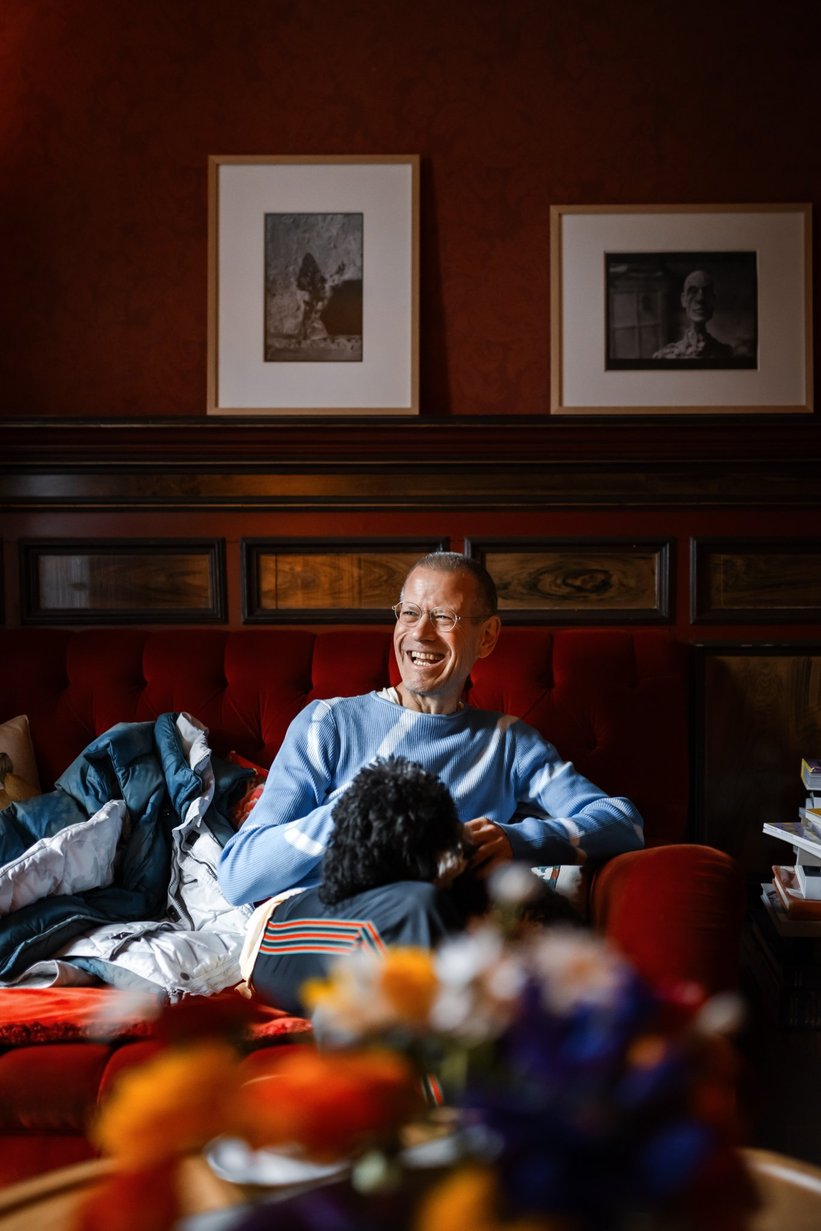
It’s a bright and sunny day in the Engadin valley when we meet Kenny Schachter at Villa Flor in S-chanf. Uncompromisingly outspoken, Kenny has made more than a handful of enemies in the multi-billion-dollar dream factory that is the contemporary art market. Like a new-millennium Truman Capote with a salt and pepper buzz cut, see-through plexiglas glasses and his trademark tie-dye long-sleeve, Kenny is loved and hated alike by the international white cube hautevolée for his unfiltered, often painfully honest columns on Artnet. We love to imagine big-time gallerists, auctioneers and collectors manically scanning through the latest, newly-released essay during their luxury luncheons, both hoping and dreading to spot their very name somewhere in Kenny’s latest flow-of-consciousness reckoning with the narcissism, hubris and greed of the art world.
But Kenny Schachter is not only an important artist, critic, curator of exhibitions, art dealer (who has negotiated the sale of a 30-million-dollar Picasso) and long-time professor at the University of Zurich – he’s also a dyed-in-the-wool car guy with a taste for the most interesting automobiles. In 2017, we first visited Kenny in his office in London Kensington, where his original Martini Racing Porsche 911 RS and an oh-so-eighties electric blue Renault 5 Turbo’s bonnet quite literally nudged his desk. Meanwhile, he has returned to his New York home, where he wrote more essays, made more enemies and curated, among others, the highly acclaimed exhibition “Unsafe at any Speed” at Morton Street Partners in 2022. On March 13, his new solo exhibition 'Art in the Age of Robotic Reproduction' will open at Jupiter Gallery in New York City.
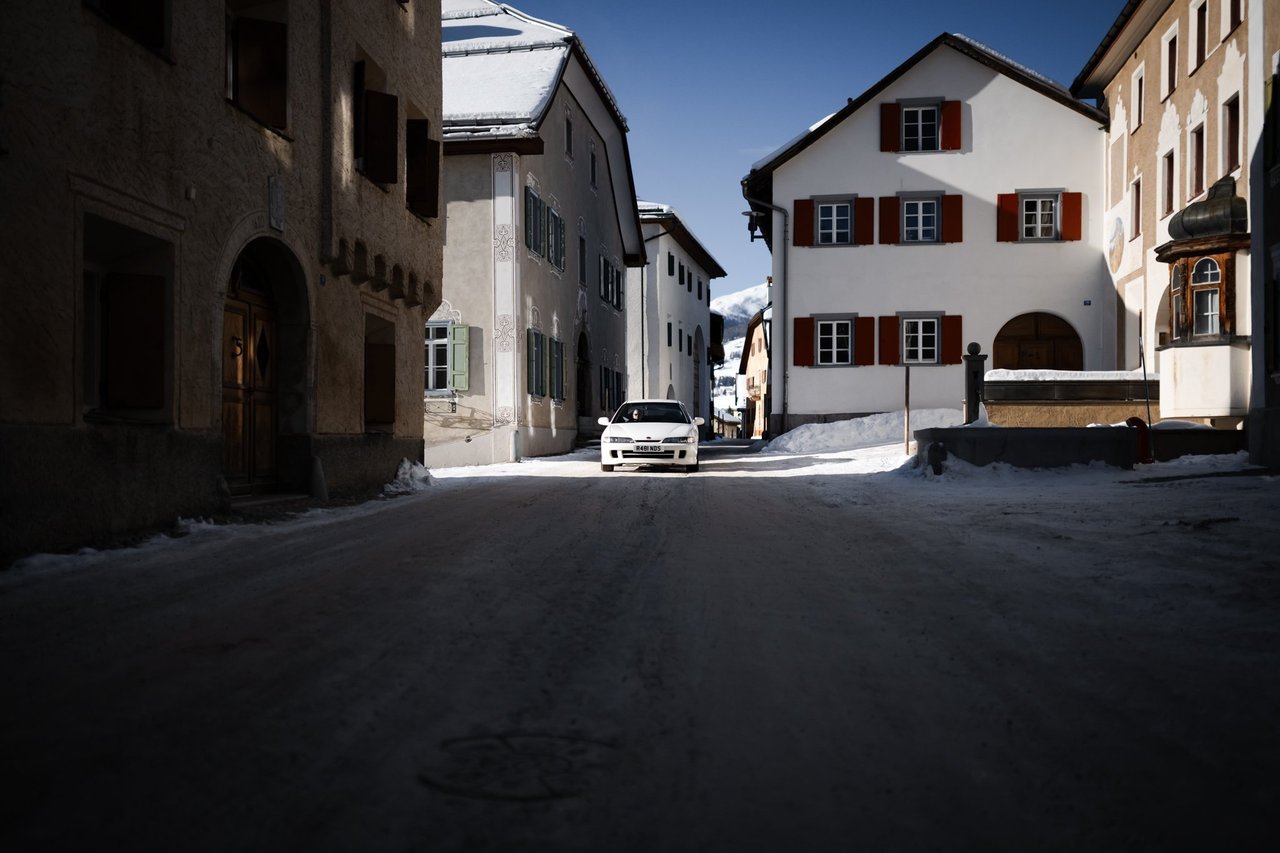
Freeze, Frieze!
This winter, though, Kenny has traded the concrete skies over Manhattan’s Upper East side with the snow and sun of the Swiss Alps. After all, ever since Bruno Bischofberger first opened an outpost of his Zurich gallery in St. Moritz in 1963, the Engadin has become a winter-time hub for the global art scene, with countless small art shows, exhibitions and pop-up gallery happenings – an alpine Art Basel, a sub-zero Frieze for the fur-coated winter jet set, so to speak. Luckily, Kenny agreed to show us some of his favourite places to visit during a one-day Engadin art expedition. So we jumped into his white 1998, Japan-spec, four-cylinder Honda Integra Type R and immediately started talking.

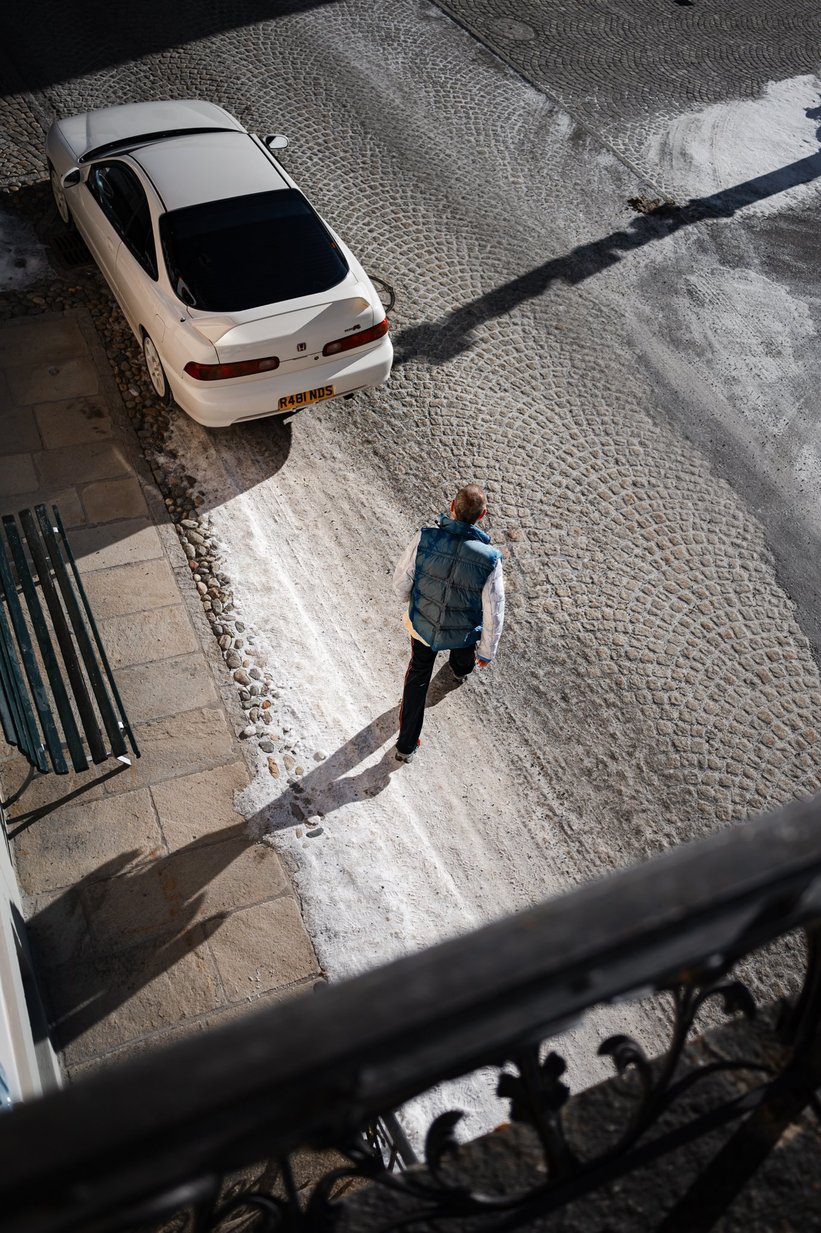
As an artist, curator, critic and dealer you’re basically a one-man-representative of the art world. But what’s your relationship with cars?
"Cars were my gateway drug to art. I had no notion that the art world existed until I was well into my 20s. I never went to galleries or museums until I was in university and found out about the commercial art world. Cars were really the first thing that attracted me aesthetically. I was never into car racing, the industrial design and the extraordinary forms seduced me. Once you have that kind of relationship, it never goes away. I would have a car in my bedroom if I could. I just love the way they smell. I love the lines, the forms, the furniture inside, and every aspect of them."

Fine art and collector cars both attract a similar, affluent and aesthetically sensitive clientel. But these both worlds rarely intersect. Sometimes there even seems to be a glass wall between the art and car bubbles. Why is that?
"I have a very non-hierarchical, democratic approach to everything. I don't differentiate between a chair, a sculpture, a fork, a spoon, or a car. Anything done with love and passion can be extraordinary. Many artists have embraced the form and the notion of cars. The French artist Sonia Delaunay-Terk has designed these extraordinary cars in the 1920s. In the 1950s, there was the Italian artist Salvatore Scarpitta who built race cars. There’s Carlo Mollino, Chris Burden, Richard Prince, Judy Chicago, Sarah Lucas – the list goes on and on. Like in cinema, cars were a symbol of freedom and independence. A lot has been written recently about young people looking for other ways of emotional fulfillment outside of the possession of paintings and sculptures – and I fear it’s even worse for cars."


The Stable, S-chanf
We arrive at our first stop as Fritz Steinhart welcomes us for a tour of The Stable in S-chanf. The exhibition space is housed in an old barn structure typically of the Engadin’s agricultural past. The gallery’s contemporary white-cube space currently displays a series of sweeping, expressionistic paintings by London artist Sophie von Hellermann. Meanwhile, the stable lending the venue its name – an ancient structure made of wood and stone, crosshatched with bright beams of sunlight shining throught the gaps between the beams – shows an installation by Swiss artist Baldassarre Ruspoli that intensifies the space’s uncanny atmosphere with nothing more than a polished stainless steel ring and a series of subtle sounds. “This hybrid notion of indoor and outdoor,” says Kenny on the way back to the car, “This quasi-protection against elements – I don't think there's any other art space like it in the world.”

You said earlier that young people are not attracted to cars anymore. Who’s to blame for that?
"Well, if you put a BMW or Porsche from the 1970s next to a car from today, you see how bloated they have become. Especially SUVs are seen as gratuitous wasteful and detrimental to the environment. But electric cars are not the solution. The batteries have a shelf life of five minutes, and you have to consider all the amounts of precious metals that are being mined to build them — not to mention the shit-ton of plastic they are crammed with. If everyone just drove smaller cars with smaller engines, and if you preserved the cars from the 1960s, 1970s, 1980s, 1990s, it would be tremendously better for the environment. Generally speaking, my cutoff point for car design is the 1990s, after that they get too big and I lose interest."


So instead of driving luxury SUVs, we should return to the more modest and simplistic cars of the past?
"It’s like Oscar Wilde said: people know the price of everything and the value of nothing. That goes for art, architecture, and also for cars. For me, a classic Mini is one of the greatest inventions in the history of engineering and design. It was coveted by the wealthy and by people with much less economic means. It was affordable for almost everybody and it remained one of the most successful, voluptuous and extraordinarily joyful things to drive – you can still get one for under 10 grand."
Have we unlearned to enjoy the true, analogue pleasures of driving?
"They say that the best security protection for a car in America is a manual transmission. That’s kind of tragic. I can't drive an automatic car, my mind starts to drift. I'm a dangerous person behind the wheel, even in the best of times. But I just love the visceral physical experience of driving a car. But I don't want to go one millimeter faster by flicking a switch on the steering wheel. I want to engage, I want to feel connected to the road and to the car."


Muzeum Susch
After a spirited drive on winding roads along the river Inn, we arrive on the entrance of the Lower Engadin valley. Built on the grounds of a rural monastery and brewery by Polish art collector and philanthropist Grażyna Kulczyk and opened in 2019, the Muzeum Susch is one of the most interesting and rewarding contemporary art destinations of the Engadin and the Swiss Alps: while the architecture creates a labyrinthine path through the building, creating insights into the geological past of the structure and surprising outlooks into the surrounding mountains, the museum’s program puts the spotlight on less well-known female artists from the 1960s to 1980s. Curatorial advisor Maciek Chorazak gives us a tour of the current exhibitions dedicated to Hungarian abstract artist Ilona Keserü and the experimental Czech photographers Běla Kolářová and Emila Medková, before we hit the road again – and quickly resume our conversation.



“It’s fascinating how the building is wedded to the region,” says Kenny on our way back to the car. “The exposed rocks, water seeping into the walls. You're seeing elements of the landscape, underneath the landscape, inside and outside, underground and above ground, all become intertwined. It's an architectural project that, in addition to the geography, embraces the local culture, while preserving the building. It’s all about preservation, and it's about exposing the work of underappreciated, underrepresented artists. Being able to see the work of this unknown 94-year-old Hungarian woman artist was a revelation.”


You write about art, you curate exhibitions, you’re an artist. But do you also consider yourself an art and car collector?
"I am more of a hoarder. I have owned over 150 cars in the last 20 years. I like to own art and cars and things and I spent a lot of time seeing them in all different lights, angles, and from different perspectives. But I also let go – every year I have an auction where I sell stuff with no reserve. I love to disrupt things and provoke the status quo of the art world. I've had cars, and I stuck them on the selling floor of Sotheby's in the middle of a painting collection. But I once had a terrible experience with a Porsche RSR. Someone accused my car of being fake, and it wasn't. It was basically a manifestation of greed and extortion. In the end I could prove that my Porsche was real, but the experience put me off cars for a long time."

But you started to get the bug again – and now you picked a Honda Integra Type R as your daily driver for the Engadine. How come?
"Last year, I was carrying all these sculptures for a museum exhibition in Austria, when a disc exploded in my back. I dropped to the street and was temporarily paralyzed. I was rushed into emergency surgery and for three weeks, I couldn't walk. When I got out of surgery, I couldn’t move my leg – but I could move my foot. I was so relieved! I knew that I was still able to step on the gas! And I immediately started looking for a new car from my hospital bed. I just love raw, lightweight sports cars. I have owned a Porsche 911 2.7 RS, which I think is one of the most extraordinary vehicles ever made. I’ve also had a 964 RS and a 993 RS. You can feel a cigarette butt under the tyre of a 964 RS Club Sport, and I was looking for that same experience without having to spend the same resources. So I started researching Honda’s Type R cars, the Civic and the Integra."


What makes these cars so interesting?
"They tick all the boxes for the things that I love, which is small-scale homologation cars engineered for the track. There are three versions of the Integra Type R, and the Japanese one has the rawest suspension and highest horsepower and torque. So I found and bought a true unicorn – a freshly imported Japanese Integra Type R with one owner, 42,000 miles, dealer service history, never modified. After a few months of physiotherapy and rehabilitation, I was able to drive again. Now this Integra for me is more fun to drive than a lot of Porsches. I don't think I've ever had as much enjoyment from something. It is basically a race car for the road."
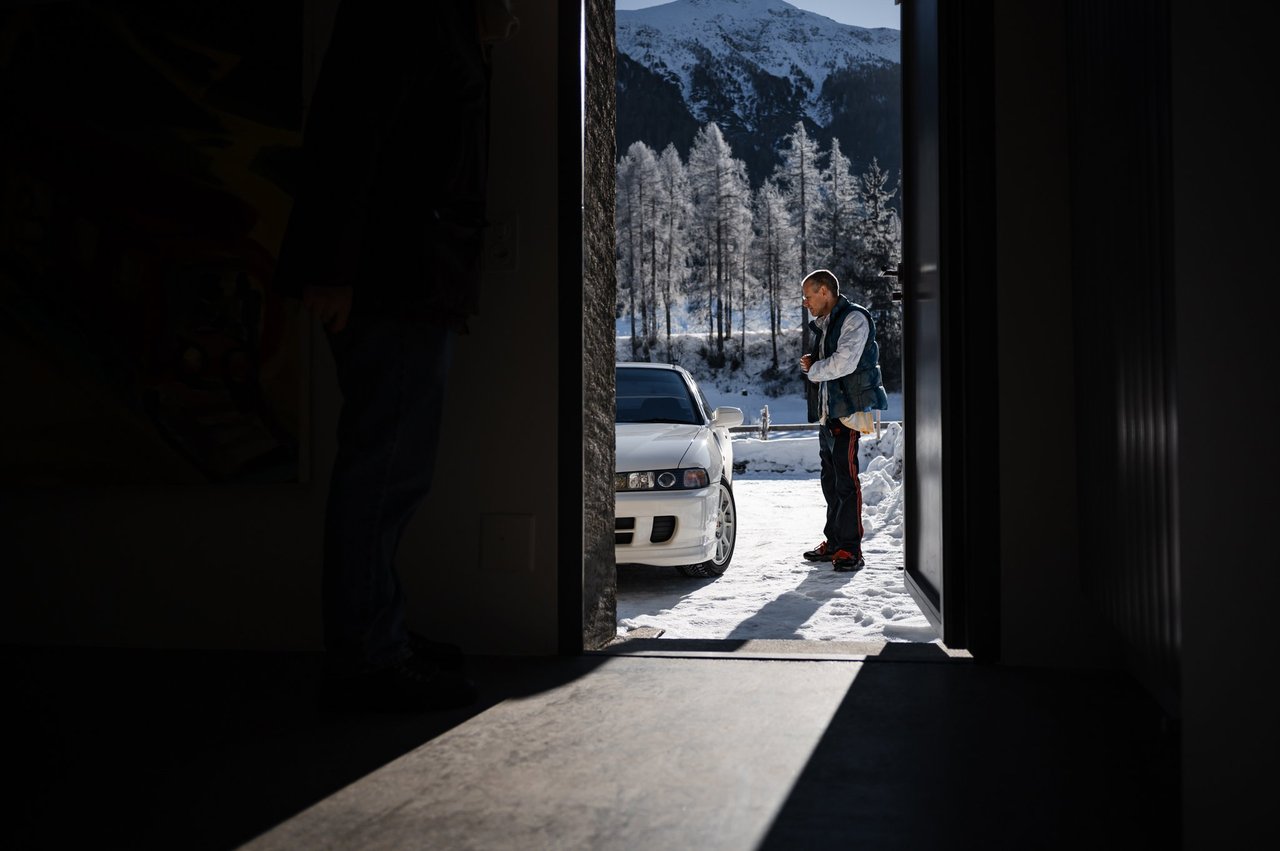
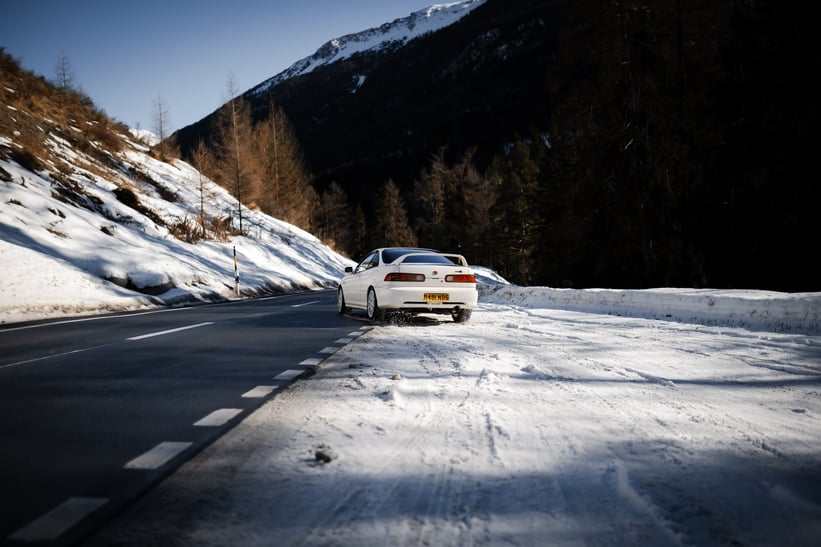

So you really came to the Engadin for the Alpine roads, and not the beautiful landscape?
"The Engadine is a magical place – the aesthetics, the landscape, the architecture and the mountains are among the most extraordinary in the world. But just like the comedian Fran Lebowitz once said: I don't want to get back to nature, I want to get back to the hotel. I’m just the same. I recoil from the sun, can’t tolerate the beach, and the only sport I engage in is full-contact art. I used to snowboard, but I have too much fear now. Give me four bars of wi-fi, and I’m anxiety free. So why would I want to drive a race-ready Honda Type R with a limited slip differential in the Alps in winter? It makes no rational sense whatsoever, but some of the greatest pursuits in life are done without any sense of caution or rationality. So all the more reason to do it! I put some snow tires on it, and it’s great fun!"
Switzerland has some of the most amazing car collections, and at events like The I.C.E. you can see some of these priceless unicorns driving on the frozen lake of St. Moritz.
"I'm not interested in those multi-multi-multi-million dollar cars hidden away in collections most of the year. Of course I love a Porsche 906, but cars are meant to be driven and if you don't drive a car, everything rots and deteriorates. There’s this amazing Jaguar D-type coming up at auction. To me, there's no difference between a Picasso and a D-type, they're just the pinnacle of human capability. But again, for $30,000, I have a Honda Integra and that car brings me as much absolute pleasure as any car that calls me. You could buy great art for $500, you could buy great cars for between $10,000 and $30,000 or $40,000, depending on what your interests are. And it's a misconception to think that great things cost a lot of money; it absolutely is untrue."

Stalla Madulain
A bit more than 10 years ago, Gian Tumasch Appenzeller and Chasper Schmidlin discovered an over 500 year old barn in Madulain – and decided to turn it into a gallery. After a careful restoration, Stalla Madulain displays and sells contemporary art, mostly from local artists or those who have been inspired in the space or while staying in the Engadin. Gian kindly shows us around the caleidoscopic group exhibition currently celebrating the gallery’s 10-year-anniversary, including local but internationally-renowned artists like Rolf Sachs or Not Vital.


In January and February, St. Moritz and the Engadin are not just a paradise for car culture – it’s also a magnet for art people. Sometimes it feels like an art theme park covered in snow because there are so many gallery openings and exhibitions. What attracts the global art crowd to come up here?
"The art world is attracted to one thing. Forget all the pretense. Forget all the verbiage about aesthetics and fine art and the pursuit of the transcendent and all this gobbledygook. Let's be plain and simple: it's all about money. But of course the galleries are here also because of the people – and the people are wonderful. It’s a winter destination at an altitude more than 6,000 feet above sea level, it’s spanning just 60 miles, but the concentration of fine art galleries and museums here is higher than at any other resort in the entire world."
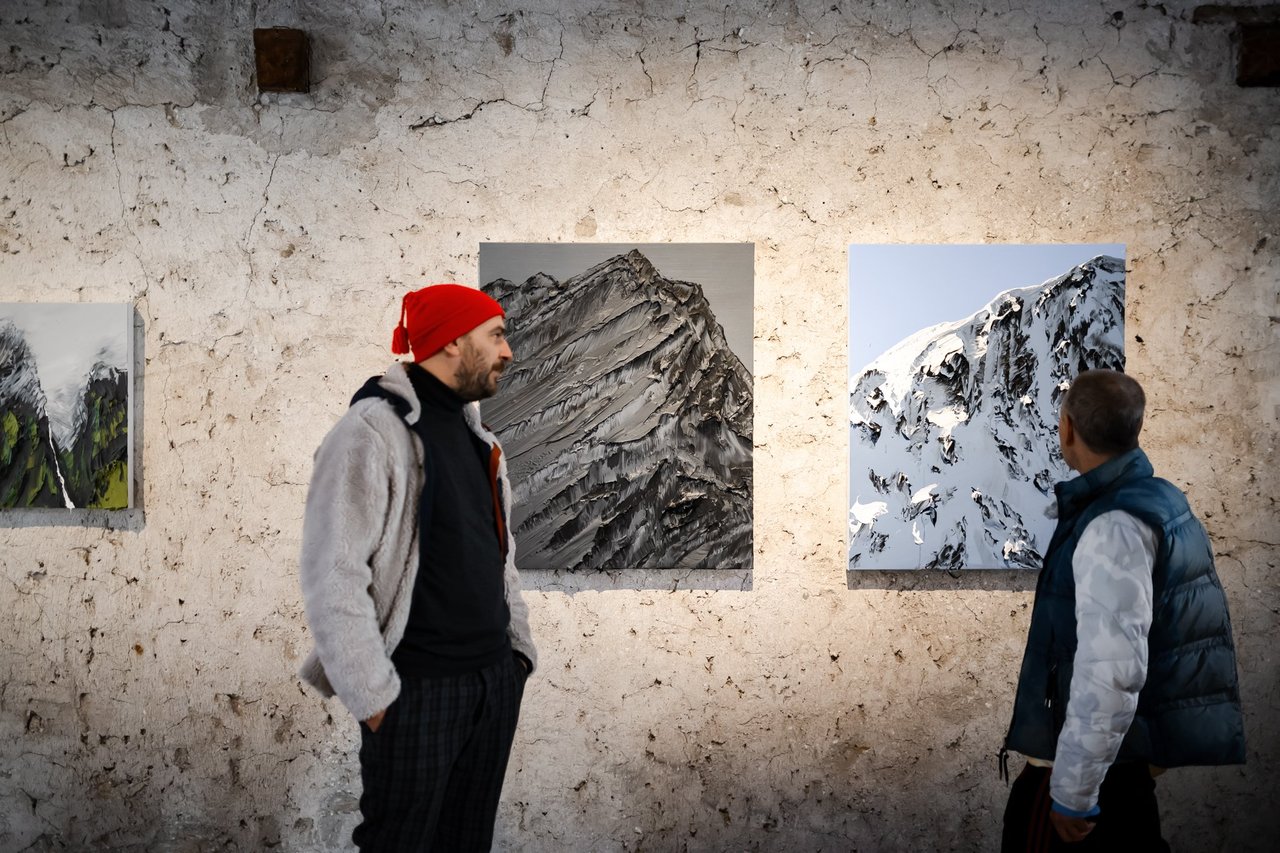
So which other shows and exhibitions did impress you the most this winter?
"Karsten Greve is showing this absolutely fascinating German artist called WOLS. He was a photographer, a painter, a writer and a musician, and to make ends meet he would buy these old sports cars and fix them up and sell them again. To me that is like the perfect notion of human creativity and experience, where you could just tie in all of your passions. Thaddaeus Ropac is doing the first pop-up exhibition in his career, showing sculptures by Swiss artist Hans Josephson in St. Moritz."


Villa Flor, S-chanf
In the Engadin, sometimes even a hotel can turn into a proper art gallery. After our spirited drive, we return to Villa Flor in S-chanf, where former ski teacher and owner Ladina Florineth welcomes Kenny with a smile. The century-old house combines ornate furnishings with contemporary architecture – and an art collection that is unique in the Engadin and beyond. Renowned artists such as Julian Schnabel, Philipp Keel and Nathalie Du Pasquier have stayed at Villa Flor and let themselves be inspired by the charm and uniqueness of the house. “There's a Julian Schnabel painting where she had to cut a hole into the ceiling to slot the painting into the wall,” says Kenny. “That is one of the coolest installations of an artwork I've seen.” This winter, the seven-room hotel housed a wonderful exhibition dedicated to the friendship between Swiss photographer Ernst Scheidegger and sculptor Alberto Giacometti. “In this intimate setting, I felt as if I was doing a studio visit with Giacometti,” says Kenny as we get back into the car. “It was amazing.”

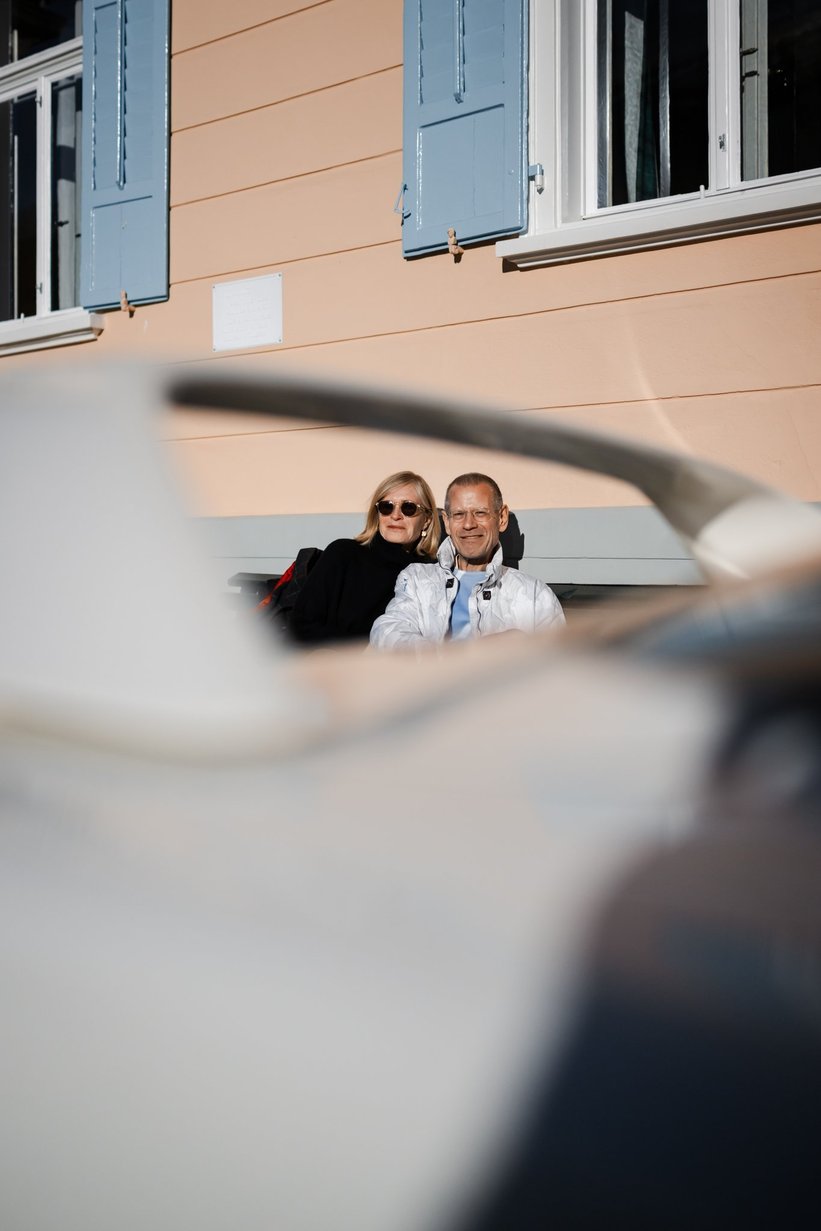
Kenny, we have a suspicion: could it be that the subject of our interests – if we are into art or cars or something entirely different – is not as important as the contacts we make through our interests, especially where these worlds intersect?
"We should all just stop pigeonholing and compartmentalizing people: you're just a car person, you're just a this, or you're just a that. We should not draw lines and parameters around various pursuits, but have an open mind – it’s all about learning, about meeting people, and staying curious. Getting along and enjoying each other's company and experience. I was never a great architecture fanatic, but I befriended Zaha Hadid because I really appreciated her accomplishments as a human being. And we ended up becoming the closest of friends and traveled all over the world together. And I was more interested in her life story and how she went against great odds. And really, Zaha designed two cars and a boat for me. She couldn't care less, but it was based on our relationship. And it was an intellectual exercise for her. I have rekindled old relationships and forged new ones with people over cars, over design in the Engadin too – just like Andrea Klainguti, who is not only a photographer but also a great rally driver and who’s family’s history is interwoven with centuries of Engadin history, or Richard Gauntlett, to whom I sold a Delta Integrale 15 years ago and who now curates this gas station coffee shop up here, the Meyers Manx Café. Cars are just a connecting point in the spectrum of human relations. Even if we are not 100% like-minded, we can always find coinciding human interests. And that gives me hope."
Photos: Andrea Klainguti for Classic Driver © 2025







































































